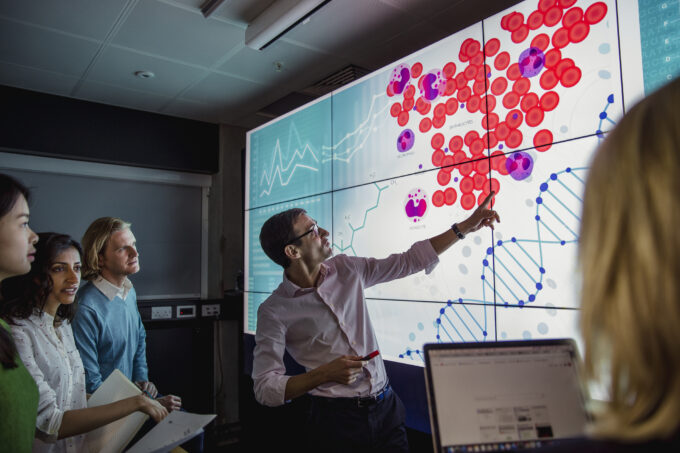A solid presentation is a valued talent in today’s competitive and dynamic world. It can open doors to success in various professional and personal undertakings. The limelight awaits you, whether you are a business professional, a student, an entrepreneur, or a public speaker, and it demands a fascinating and compelling performance. Behind every spectacular presentation are painstaking preparation and an awareness of the keys to capturing your audience’s attention and appreciation.
Generating a presentation is about more than just gathering materials. In fact, it is a lot more! It entails a planned balance of material, delivery, and audience involvement that may transform an average presentation into an excellent one. This article reveals the secrets of effective presentations, helping you through the necessary presentation preparation stages to capture your audience and leave a lasting impression.
By implementing the secrets into your preparation process, you can boldly walk into the limelight and make a presentation that educates, inspires, persuades, and connects on a deeper level with your audience.
Top Secrets To Delivering A Powerful Presentation

Whether you are preparing for an important business pitch, an academic presentation, or a public speaking engagement, these secrets will enable you to prepare for the limelight and make a strong presentation that will resonate with your audience. But first, let’s uncover the fundamental methods to distinguish you as a superb presenter.
Define Your Purpose And Objective
Defining your purpose and goals is crucial in putting together a strong presentation. It entails specifying the main message you want to get through. Your purpose establishes a compass that directs your presentation’s content, organization, and delivery. For instance, what do you want to accomplish with this presentation? Knowing your objective will enable you to develop an engaging story that supports your intended results.
Furthermore, having specific goals gives your presentation structure and concentration, making you more successful. Well-defined objectives ensure that every element of your presentation has a purpose, whether to influence decision-making, pique curiosity or encourage interaction.
Early purpose and objective definition lay the groundwork for a strong presentation that engages the audience and yields the desired outcomes.
Know Your Audience
Figuring out your audience is the key to developing a solid presentation. By this, you may modify your content, phrasing, and delivery to appeal to their particular needs and interests. You should learn more about your audience’s demographics, expertise level, preferences, and expectations by conducting prior research on them.
This knowledge enables you to adapt your writing, pick pertinent examples, and utilize acceptable and meaningful language for your listeners. Additionally, it can help you establish a connection with them early on and keep their interest throughout the presentation.
Knowing their past and viewpoint is also essential as it enables you to foresee any queries or worries, allowing you to answer them proactively and establishing credibility. In the end, create a strong presentation that speaks directly to their needs and shows a genuine connection by tailoring it to meet the particular qualities of your audience.
Structure Your Presentation

The smooth flow of information in a well-structured presentation makes it simpler for your audience to follow along. Follow the structure below for a long-lasting impact:
Captivating Opening
Get your audience’s attention right away with a catchy hook. For instance, it could be a provocative query, a fascinating tale, or a startling fact.
Clearly Stated Aim
To establish the tone for the remainder of the presentation, clearly define your primary aim or critical message.
Supporting Points
Divide your information into logical divisions, each segment concentrating on a crucial supporting argument. Use transitions to lead your people from one idea to the next effortlessly.
Powerful Visuals
Use pertinent and eye-catching slides to support your points. To improve understanding, utilize bullet points, photos, and graphs rather than stuffing your presentations with text.
Strong Conclusion
Summarize your primary ideas and bring your essay to a satisfying conclusion that will stick with your audience. To stimulate crowd participation after the presentation, think about concluding with a challenge or a remark that makes you stop and think.
Mastering Non-Verbal Communication

Nonverbal signals such as body language, facial expressions, and gestures transmit meaning, emotions, confidence, and words. Taking note of your nonverbal communication improves your overall presence and connection with the audience.
Maintain eye contact to build connection and interest your crowd. Stand upright with a solid posture and use purposeful motions to emphasize central themes and keep the audience interested. Facial expressions should convey sincerity and excitement while reflecting the tone and subject of your presentation.
To successfully convey your message, be aware of your voice’s tone, cadence, and loudness. Your spoken remark should be supported and strengthened by your nonverbal cues. By recognizing nonverbal cues, you can establish a persuasive presence, draw in your viewers, and ensure your message is received and understood.
Practice, Practice, Practice
By practicing, you may improve your delivery, familiarize yourself with the subject matter, and boost your confidence. You may improve your timing, tone, and body language through practice, resulting in a seamless and exciting presentation. Also, identify any areas that need development and make the necessary adjustments by practicing multiple times.
The practice also helps you internalize the content, allowing you to present it more naturally and fluidly. To examine and improve your presentation, consider recording yourself or practicing in front of a mirror. The more practice you get, the more prepared you will be to manage unforeseen events and connect with your audience, culminating in a compelling and impactful presentation.
Engage Your Audience
Engaging your audience entails making a connection and holding their attention throughout your presentation. To stimulate active engagement, include interactive components such as questions, polls, or group activities. Share tales, stories, or instances that are relevant to your crowd.
Use visual aids, such as slides or objects, to help students understand and engage their visual senses. Maintain a conversational tone and aggressively engage your audience by soliciting their opinions, ideas, or comments. You create a dynamic and interactive experience by engaging your viewers, which makes your presentation memorable and compelling.
Handle Q&A With Confidence

A confident approach to Q&A sessions is essential for an excellent presentation. Prepare short, well-thought-out replies to queries. Listen to each question and make sure you understand it. Maintain eye contact with the questioner and remain calm.
If you don’t know the answer, be honest and offer to provide additional information later. Maintain an open mind to other points of view and address any challenges or arguments with respect.
Respond confidently and clearly, addressing the concerns of the questioner. Handling Q&A sessions confidently shows your experience, creates credibility, and makes a great impression on your target group, reinforcing the effect of your presentation.
Conclusion
Preparing for an effective presentation necessitates a deliberate combination of planning, communication skills, and audience interaction. You may take your productions to new heights and create a lasting impression on your crowd by adopting the techniques revealed.
Remember, it is very important to establish a strong connection with your audience so that they understand what you speak. Ultimately, this would also lead to presentation delivery satisfaction! So, accept these secrets, practice rigorously, and you shall be able to realize your full potential as a compelling presenter.









